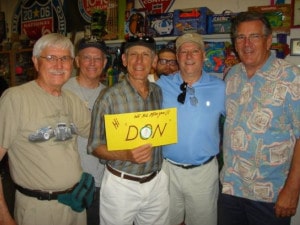“Mr. Speaker, esteemed delegates, colleagues, masters, novices, collectors, and friends. It is my unique honor and pleasure to stand before you (while sitting behind this keyboard) to state unequivocally that the STATE OF WOOD IS GOOD…”
Seriously though, I’m stoked out of my mind about it.
I’ve been playing and pushing wood yo-yo’s pretty hard now for 10 years. That was when I got my first No Jive yo-yo from Dave’s Skill Toys. Shortly thereafter, I committed to what I called a “fixed axle lent”, throwing all wood for 40 days. Looking back, that seems like the most tentative commitment imaginable (having thrown one fixed axle yo-yo for ALL of 2012 and having thrown mainly fixed for the past few years). Regardless, it opened the door for me, and set me on the path I’m on. And a decade down the road, I’m humbled and mega-amped to be able to share a version of that same No Jive with my name on it (and, through the magic of Jason Week and laser-engraving, my silhouette).

For awhile – a LONG time – it felt like the practice of throwing wood yo-yo’s was dying an agonizingly slow death. Our community was still collectively figuring out the best practices for designing competition-grade aluminum ball-bearing yo-yo’s, and the pathways those tools illuminated were still too new and exciting for many to look away (much less tackle the dark and rocky uphill battle which fixed axle represents). At that time, it was mostly collectors keeping it alive, along with a few key players who had come up throwing fixed, and who knew that a REAL player can make most any yo-yo look incredible.
It may seem that I’ve been using “wood” and “fixed axle” interchangeably. They are not always the same. You’ve got ball-bearing wood models like the RD-1 on this site, and you’ve got plastic (and even metal) fixed axle yo-yo’s out there as well. However, TO ME, wood and fixed will always be joined at the hip. To me, wood is the best material for a fixed axle yo-yo, and fixed-axle is the best design for a wood yo-yo. The low density and smooth surface of the material complements the style, while its natural inconsistencies don’t interfere as much as they do with long-spin ball-bearing designs. It is (obviously) a delightfully “organic” material, which feels more at home out under the clouds than it does on the no-mistakes-allowed freestyle stage. Plus, I think wooden yo-yo’s just maintain a classic look and feel that will always complement the “original” style of yo-yoing.
Actually, it’s fascinating and awesome to me that the same yo-yo’s that were best for that classic, simplistic style of loop-the-loop, skin-the-cat, shoot-the-moon, and the occasional “long” sleeper have REMAINED the best tools for what has become the progressive (and sometimes esoteric) style which modern fixed axle has become. It was pretty much impossible to beat a No Jive back in the early 80’s, and for the stally-flippy tech of modern fixed axle play, they still give most any model a run for their money.

Wooden yo-yo’s remain the acoustic guitars to modern yo-yo’s amplified, solid-body shredders. They’re the heavy, 10-foot koa surfboards of Duke Kahanamoku to ball-bearings’ “shortboard revolution”. They’re thousand year-old shaolin kung fu to the ground-n-pound MMA of competitive 1a. There’s no denying that wooden yo-yo’s are antiquated; even primitive. Place a wooden yo-yo next to the 7075 aluminum, post-space age, splatter-anodized masterpieces that dominate the scene today, and the two yo-yo’s hardly look like they belong in the same phylum (which makes sense, since wood was once alive and actually does have a specific phylum).
And yet, despite all its difficulty, despite its low tolerances and high-maintenance, and despite its simplistic construction, a steady stream of players continue to gravitate to playing wood. Actually, I think it’s BECAUSE of those factors, and not “despite” them. Chucking wood offers a counterpoint to throwing modern metal. And it’s not some evangelical, cloistered practice from which there’s no return… it actually ENHANCES your bearing play. It gives it context and helps you appreciate the luxuries of time and complexity, taking your play in new directions.
When we’ve played yo-yo for awhile, we start to tie stuff onto it. Win titles, make money, get sponsored, get 100 likes on our new video, etc. That stuff becomes baggage, and it can be hard to have fun under the weight of it. But ironically, we can sneak out from underneath it by JUST PLAYING, without any kind of acquisitive spirit. That kind of change helps shut down your “autopilot” and reminds you that yo-yoing is more about having fun and exploring than it has ever been about getting stuff. It’s easier to find that state on wood for some reason – perhaps because it goes kind of “against the grain” (pun), or maybe because it brings us back to our collective beginnings. It’s restorative. The “Play Simply” philosophy isn’t about doing simple tricks. It’s about doing tricks for simple reasons, and with a simple heart.
More and more players are seeing the value in that, and fixed axle has shifted into a higher gear as a result. You’ve got guys like Drew Tetz who continue to amaze with yo-yo’s that cost less than a fast food cheeseburger (and who’s 44RPM company brims with radical toy designs). You have a clutch of fixed axle purists sharing the exploits of a year spent focusing on fixed-axle at Yoyoexpert. You have Colin Leland at TMBR continuing to put out revolutionary designs with old-world levels of craftsmanship. You have tons of players who, for reasons already noted, are seeing the value in throwing fixed as a complement to their “regular” play. And then you’ve got us. Tom Kuhn will continue to make the fixed axle yo-yo’s that he originally believed the world needed. And I’m gonna keep throwing them until my arm falls off.
With every player that gives wood a go today, manufacturers have another reason to experiment with the medium, and the already rife potential of the fixed-axle trick landscape expands exponentially. For years now, it’s been easy to say that this is a great time to be a yo-yo player; a “golden age”, as it were. So many killer freestyles to watch, so many unbelievable tricks to learn, so many near-perfect models to try. But for the first time in years, I feel like this is a great time to be a WOOD yo-yo player.
– ed haponik
